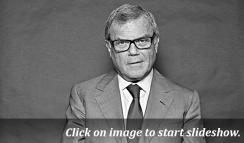Given the precarious state of world affairs — anemic expansion in the euro zone, slowing real gross domestic product growth in many emerging markets, political unrest in the Middle East and other areas — it’s hardly surprising that multinational corporations are sitting on a massive $7 trillion in cash, waiting for a safer set of circumstances in which to ramp up hiring, acquiring and expanding.
Even more amazing, however, is that select company leaders have demonstrated a willingness to do something that doesn’t come easily in strapped times: take risks. And they are being rewarded for their courage.
“We’ve managed to grow when others have remained cautious because we’ve been willing to experiment,” attests Martin Sorrell, chief executive officer of WPP, the world’s largest advertising agency group, by revenue. “We’ve not taken massive bets, but we’ve made measured bets, and we’re really making sure we think about change in a meaningful way.”
That attitude helped the U.K.-based outfit expand revenue by 4.6 percent in 2014, to £11.53 billion ($17.91 billion), despite a drag from currency exchange rates of nearly 7 percent. It also has secured WPP a spot on the 2015 All-Europe Executive Team, Institutional Investor’s exclusive annual ranking of the region’s top CEOs, CFOs, investor relations teams and IR professionals. This year’s results reflect the opinions of nearly 870 buy-side analysts and money managers at 485 firms that collectively manage an estimated $4.5 trillion in European equities, and from 1,110 analysts from nearly 160 sell-side institutions.
A number of the companies on this year’s team also appear on II’s inaugural ranking of Europe’s Best Analyst Days.
Many other managers at businesses on this year’s team have embraced intrepid strategies. Executives at Reckitt Benckiser Group, for example, are honing a new focus on consumer health, having recently spun off its pharmaceuticals unit. “This has been a conscious effort to sharpen the company’s portfolio around what we want to be good at — no, not just good at, the best at,” insists Rakesh Kapoor, CEO of the U.K.-based consumer goods giant.
5 Tips on Innovation from Europe’s Top Executives

ASML Holding, the world’s largest supplier of the photolithography machines used in the production of computer chips, bought U.S.-based Cymer in 2013 so that the Dutch manufacturer could expand into laser technology. As a key supplier to the semiconductors industry, ASML must keep pace with Moore’s Law — named after Intel Corp. co-founder Gordon Moore — which holds that new semiconductors should double their performance every 18 months without increasing in price. This requires chip providers to pack more and more transistors onto new-generation integrated circuits, calling for smaller and smaller transistors.
Following the Cymer acquisition, ASML has been able to produce its finest paintbrush ever: extreme-ultraviolet-lithography machines. The breakthrough helped the company realize record net sales of €5.86 billion ($7.12 billion) last year, up 12 percent over 2013. CFO Wolfgang Nickl adds that the company’s first-quarter figures in 2015 set the company on track for another record-breaking year.
“There was a lot of doubt over the last couple of years about whether the technology was going to be successful,” he recalls. “But we achieved a major milestone.”
French oil services provider Technip also set a sales record in 2014, a goal achieved by helping its clients save money as oil prices were plummeting. “The big prize is if we can reduce the cost of a project significantly by being innovative not just by slashing prices,” says CEO Thierry Pilenko.
Although many may wonder where the price of oil is heading, the producers aren’t sitting around waiting for an answer.
“It’s important to realize that the industry isn’t stopping,” he says. “The industry is reshaping itself. This is where the companies that have the most creativity and flexibility and are closest to the clients — these companies are the ones that are going to get stronger and emerge as the winners as we get out of this low-price environment.”






